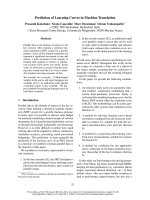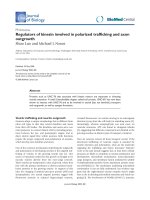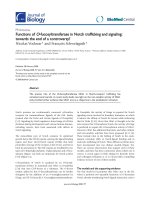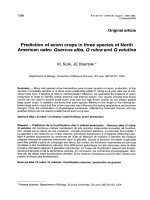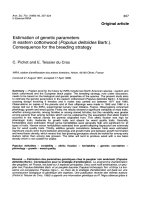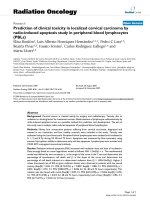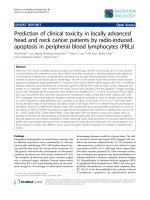Báo cáo sinh học: "Prediction of genetic gains in body weight, egg production and shell quality traits in the Brown Tsaiya laying duck" pps
Bạn đang xem bản rút gọn của tài liệu. Xem và tải ngay bản đầy đủ của tài liệu tại đây (789.33 KB, 13 trang )
Original
article
Prediction
of
genetic gains
in
body
weight,
egg
production
and
shell
quality
traits
in
the
Brown
Tsaiya
laying
duck
(Anas
platyrhynchos)
YS Cheng
1
JP
Poivey
R
Rouvier
C
Tai
2
1
Station
d’amélioration
génétique
des
animau!,
centre
de
recherches
de
Toulouse,
Institut
national
de la
recherche
agronomique,
!
BP
27,
.i1326
Castanet-Tolosan
cedei,
France
2
Taiwan
Livestock
Research
Institute,
112
Farm
Road
Hsin-Hua,
Tainan,
71210
Taiwan,
Republic
of
China
(Received
13
June
1995;
accepted
16
August
1996)
Summary -
An
evaluation
was
made
of
the
expected
genetic
gain
and
predicted
genetic
responses
for
egg
weight
and
body
weight
at
40
weeks
of
age
(EW40,
BW40),
number
of
eggs
laid
up
to
52
weeks
of
age
(NEGG52),
eggshell
strength
at
30
or
40
weeks
of
age
(ES30
or
ES40)
in
Brown
Tsaiya
laying
ducks
selected
for
five
generations
by
independent
culling
levels,
first
on
a
linear
phenotypic
index
for
the
first
three
traits,
and
then
on
ES30
or
ES40.
The
genetic
parameters
estimated
in
the
base
population
were
used
to
calculate
the
expected
genetic
gains
in
one
generation
of
selection.
The
genetic
responses
per
generation
were
evaluated
by
averaging
the
multitrait
best
linear
unbiased
prediction
(BLUP)
animal
model
predictors
and
regressing
them
on
generation
number.
The
per
generation
genetic
responses
were
+0.177
g
(EW40);
+8.029
g
(BW40);
+0.935
eggs
(NEGG52);
+0.017
kg/cm
2
(ES30);
+
0.014
kg/
CM
2
(ES40).
These
values
fit
the
expected
genetic
gains
for
NEGG52,
but
they
are
higher
than
those
for
BW40
and
lower
than
those
for
ES30
and
ES40.
It
was
shown
that,
compared
to
the
selection
method
which
has
been
used
and
with
the
same
selection
intensity
in
female
ducks
(i
=
1.271),
constrained
selection
based
on
a
phenotypic
selection
index
or
a
genetic
index
could
increase
the
expected
genetic
gains
in
NEGG52
by
a
factor
of
3.5
or
5.7,
respectively,
while
maintaining
constant
EW40
and
BW40.
genetic
gain
/
selection
/
laying
duck
/
restricted
selection
index
Résumé -
Prédiction
des
gains
génétiques
sur
des
caractères
de
poids
corporel,
de
production
d’oeufs
et
de
qualité
de
la
coquille
chez
la
cane
pondeuse
Tsaiya
Brune
(Anas
platyrhynchos).
Les
gains
génétiques
attendus
et
les
réponses
génétiques
prédites
du
poids
de
l’oeuf
et
du
poids
corporel
à
l’âge
de
40
semaines
(EW40,
BW40),
du
nombre
*
Correspondence
and
reprints
d’oeufs
pondus
jusqu’à
l’âge
de
52 semaines
(NEGG52),
de
la
solidité
de
la
coquille
aux
âges
de
30
et
40
semaines
(ES30
ou
ESl!O)
chez
la
cane
pondeuse
Tsaiya
Brune
sélectionnée
pendant
cinq
générations
ont
été
calculés.
La
sélection
par
niveaux
indépendants
était
basée
sur
un
premier
choix
des
50%
meilleures
femelles
d’après
leurs
valeurs
individuelles
d’un
indice
de
sélection
massale
sur
les
trois
caractères
EW40, BW40,
NEGG52
et
sur
un
dév,!ièmé
choix
portant
sur
les
valeurs
individuelles
de
ES30
(deux
premières
générations)
puis
de
ES40
à
partir
de
la
troisième
génération.
Les
reproducteurs
mâles
étaient
choisis
de
façon
comparable
à
partir
de
l’information
sur
leurs
soeurs.
Au
total,
!482
femelles
et
2 093
mâles
ont
été
étudiés.
Pendant
les
quatre
premières
générations,
en
moyenne
25,6%
des
femelles
et
12,2%
des
mâles
furent
sélectionnés.
À
partir
des
paramètres
génétiques
de
la
population
de
base,
les
gains
génétiques
attendus
ont
été
calculés.
Les
réponses
génétiques
par
génération
ont
été
estimées
par
ailleurs
à
partir
des
moyennes
des
prédicteurs
de
valeurs
génétiques
du
BL
UP
modèle
animal,
en
calculant
la
régression
des
moyennes
en
fonction
du
numéro
de
génération.
Les
réponses
par
génération
sont
de
+ 0,177g
(EW40);
de
+ 8, 029
g
(BWl, 0);
de
+ 0, 935
ceufs
(NEGG52);
de
+ 0, 017
kg/cM
2
(ES30);
de
+ 0, 014
kg/cm
2
(ES40).
Ces
valeurs
correspondent
au
gain
génétique
attendu
pour
NEGG52,
elles
sont
plus
fortes
pour
BW40
et
plus
faibles
pour
ES30
and
ES40.
Il
est
montré
que,
par
rapport
à
la
méthode
de
sélection
qui
a
été
appliquée
et
avec
la
même
intensité
de
sélection
chez
les
canes
(i
=
1, 271),
la
sélection
avec
contraintes
sur
un
indice
de
sélection
massale
ou
un
indice
génétique
sur
quatre
caractères
pourrait
multiplier
le
gain
génétique
attendu
de
NEGG52
par
3,5
et
5,7 respectivement,
tout
en
maintenant
constant
le
poids
de
l’ce
uf
(EW40)
et
le
poids
corporel
(BW40).
gain
génétique
/
sélection
/
cane
pondeuse
/
indice
de
sélection
avec
contraintes
INTRODUCTION
The
native
breed
Brown
Tsaiya
(Anas
platyrhynchos)
is
a
major
breed
of
laying
duck
in
Taiwan.
A
selection
for
the
four
traits
of
egg
weight
and
body
weight
at
40
weeks
of
age
(EW40
and
BW40),
number
of
eggs
laid
up
to
52
weeks
of
age
(NEGG52),
eggshell
strength
at
30
weeks
of
age
(ES30,
first
two
generations)
and
at
40
weeks
of
age
(ES40,
from
generation
three)
has
been
conducted
at
the
Ilan
Branch
of
the
Taiwan
Livestock
Research
Institute
since
1984.
The
selection
was
made
by
independent
culling
levels,
first
on
the
values
of
a
restricted
phenotypic
selection
index
for
three
traits
EW40, BW40,
NEGG52
and
then
on
the
ES30
or
ES40.
There
was
no
unselected
control
population.
Cheng
et
al
(1995)
estimated
the
genetic
parameters
in
the
base
population
by
REML
applied
to
a
multiple
trait
animal
model
based
on
data
of
the
first
five
generations
of
selection.
The
selection
goals
of
this
breeding
program
at
present
are
to
maintain
EW40
and
BW40
at
their
current
genetic
levels,
to
increase
as
much
as
possible
the
genetic
level
in
NEGG52,
while
getting
a
positive
genetic
response
on
ES30
and
ES40.
It
is
therefore
useful
at
this
stage
to
evaluate
the
genetic
responses
and
to
determine
the
most
efficient
multitrait
selection
index
in
order
to
get
the
desired
gains.
From
early
research
it
is
now
well
known
that
theoretically
the
selection
index
for
several
traits
is
more
efficient
than
the
independent
culling
levels
procedure;
the
superiority
may
depend
on
the
number
of
traits,
the
economic
weights
and
the
genetic
correlations
(Minvielle,
1990).
Since
Hazel
(1943),
the
conventional
selection
index
for
multiple
trait
has
been
extended
by
several
workers
to
take
into
account
information
from
relatives
(Henderson,
1963;
Rouvier,
1969ab,
1977).
One
of
the
classical
selection
indices
with
restrictions
for
egg
size,
body
weight
and
egg
production
rate
in
poultry
selection
was
presented
by
Hogsett
and
Nordskog
in
1958.
The
theory
of
restricted
selection
indices
(Kempthorne
and
Nordskog,
1959)
or
indices
for
desired
gains
has
been
further
developed
(Mallard,
1972;
Itoh
and
Yamada,
1987).
When
the
means
are
unknown
and
the
estimated
variances
and
covariances
used
are
not
very
different
from
their
true
values,
multiple
trait
evaluation
by
best
linear
unbiased
prediction
(BLUP)
can
be
used
(Henderson
and
Quaas,
1976;
Schaeffer,
1984;
Ducrocq,
1994).
Some
applications
with
an
animal
model
have
been
made
recently
by
Hofer
et
al
(1992)
and
Ducos
(1994)
for
genetic
evaluation
in
swine,
and
by
Besbes
(1993)
for
laying
hens.
A
restricted
BLUP,
the
BLUP
counterpart
of
restricted
selection
index,
has
been
derived
by
imposing
restrictions
on
the
multitrait
mixed-model
equations
(MME)
(Quaas
and
Henderson,
1976;
Henderson,
1984).
Lin
(1990)
gave
a
unified
procedure
for
computing
both
a
restricted
BLUP
and
a
restricted
selection
index
for
multiple
trait
(MT).
The
purpose
of
this
study
was
to
predict
the
breeding
value
by
an
MT-BLUP
procedure
using
an
animal
model
in
order
to
evaluate
the
genetic
responses
and
to
study
the
expected
genetic
gains
calculated
by
the
conventional
methods.
The
results
would
then
be
used
to
discuss
the
possible
application
of
a
restricted
genetic
selection
index
for
MT
and
maximum
gain
on
the
number
of
eggs
laid
up
to
52
weeks
of
age.
MATERIALS
AND
METHODS
Selection
method
A
restricted
selection
index
h
based
on
egg
weight
at
40
weeks
of
age
in
grams
(EW40),
body
weight
at
40
weeks
of
age
in
grams
(BW40)
and
number
of
eggs
laid
up
to
52
weeks
of
age
(NEGG52)
was
first
applied
to
select
50%
of
the
female
ducks.
This
restricted
selection
index
was
constructed
with
conventional
estimated
genetic
parameters
(table
I)
to
increase
the
number
of
eggs
while
holding
egg
weight
and
body
weight
constant
in
Brown
Tsaiya
(Tai
et
al,
1994).
As
the
heritabilities
of
ES30
and
ES40,
and
their
genetic
correlations
with
the
three
previous
traits
were
unknown,
among
these
50%,
the
top
50%
of
the
best
female
ducks
was
selected
for
ES30
in
the
first
and
second
generations
(Gl
and
G2)
and
for
ES40
from
the
third
generation
(G3)
of
selection
by
independent
culling
levels.
Eggs
laid
over
five
consecutive
days
at
30
and
40
weeks
of
age
were
weighed
and
measured
by
eggshell
meters
(unit:
kg/cm
2)
for
the
average
of
ES30
and
ES40.
The
drakes
were
chosen
within
sire
using
information
from
four
full
sisters:
first
35%
of
them
on
the
averages
of
h
and
then
35%
on
averages
of
ES30
or
ES40.
On
average
in
G1
up
to
G4,
12.2%
of
the drakes
and
25.6%
of
the
female
ducks
were
selected.
In
G1
up
to
G5,
the
data
from
3 482
female
and
2 093
male
offspring
were
recorded
(Cheng
et
al,
1995;
table
II).
Computation
of
breeding
values
and
predicted
genetic
responses
Theoretically,
an
MT
animal
model
which
accounts
for
covariances
among
traits
should
reduce
the
prediction
error
variance
of
predicted
breeding
values
(Schaeffer,
1984;
Thompson
and
Meyer,
1986).
Therefore,
the
same
data
for
the
five
traits
(EW40,
BW40,
NEGG52,
ES30
and
ES40),
the
heritabilities
and
phenotypic
and
genetic
correlations
estimates
for
these
five
traits
were
taken
from
Cheng
et
al
(1995)
for
computation
of
breeding
values
(table
I).
The
pedigree
information
was
traced
to
the
founder
animals
(GO)
which
were
assumed
to
be
unrelated
(table
II).
Hatch
batches
(26
levels)
and
sexes
(for
BW40)
were
assigned
as
fixed
effects.
Predicted
breeding
values
of
the
five
traits
were
calculated
by
an
MT-BLUP
animal
model
that
accounts
for
inbreeding
using
the
PEST
program
(Groeneveld,
1990;
Groeneveld
and
Kovac,
1990;
Groeneveld
et
al,
1992).
The
genetic
responses
for
each
trait
were
estimated
from
the
regression
of
the
MT-BLUP
breeding
values
of
female
ducks
on
generation
number.
The
phenotypic
selection
differentials
for
each
trait
were
calculated
in
female
ducks
only.
Multitrait
selection
index
and
expected
genetic
gains
The
expected
genetic
gains
for
one
generation
which
correspond
to
the
applied
selection
index,
have
to
be
calculated
in
order
to
compare
them
with
the
predicted
genetic
response.
They
also
have
to
be
calculated
when
selecting
on
multitrait
selection
index
to
make
possible
improvement
of
the
selection
efficiency.
The
expected
genetic
gain
in
each
traits
was
based
on
the
regression
of
its
additive
genetic
value
on
the
selection
differential
in
the
selection
index.
Selection
on
individual
phenotypic
values
In
the
present
case
the
selection
was
based
on
a
restricted
phenotypic
selection
index
h
=
b’y
for
the
three
traits
EW40,
BW40
and
NEGG52.
The
vector
b
was
chosen
in
order
to
fit
the
restrictions
of
no
genetic
change
for
EW40
and
BW40.
Selection
on
the
predicted
individual
breeding
values
If
g
is
the
vector
of
predictors
of
breeding
values
for
each
of
the n
traits
of
an
animal,
it
is
straightforward,
according
to
the
classical
theory
(Rouvier,
1969ab,
1977;
Mallard,
1972),
to
combine
them
in
a
genetic
index
Ig
=
a’g
where
a
is
the
vector
of
coefficients
for
the
n
breeding
values,
a’
is
a
transposed,
and
g
is
the
vector
of
predictors
of
breeding
values
for
each
of
the
n
traits,
calculated
as
the
multiple
regression
of
g
on
all
the
phenotypic
predictors.
Following
Lin
(1990)
the
vector
of
the
coefficients
in
the
restricted
genetic
index
12
=
v’g
has
been
calculated
with
constraints
of
0.0
and
0.013
kg/cm
2
for
genetic
gains
in
EW40,
BW40
and
ES40
respectively
and
maximum
gain
in
NEGG52
(with
a
selection
intensity
i
=
1).
The
matrix
of
additive
genetic
variances
and
covariances
of
the
n
traits
was
assumed
to
be
known.
The
matrix
E(g g’)
= B
was
approximated
by
B,
the
variance-covariance
matrix
of
the
MT-BLUP
breeding
values
in
an
animal
model.
RESULTS
Expected
genetic
gains
for
the
selection
method
used
Table
III
gives
the
expected
genetic
gains
for
female
ducks
in
one
generation
for
EW40,
BW40,
NEGG52,
ES30
and
ES40
when
selecting
by
independent
culling
level
on
the
index
h
with
p
=
50%,
and
on
ES30
or
ES40
with
p
=
50%.
Since
h and
ES30
or
ES40
are
phenotypically
uncorrelated,
the
formulas
of
Young
and
Weiler
(1961)
simplify
to
calculate
the
selection
intensities
which
are
i
=
0.789
for
h
and
the
same
for
ES30
or
ES40.
In
total
25%
of
the
female
ducks
are
theoretically
selected
with
this
procedure.
The
expected
genetic
gains
for
male
ducks
in
one
generation
are
similar,
being
+
0.595,
+
0.490
for
EW40,
+
5.245, -
1.290
for
BW40,
+ 0.974,
+ 0.993
for
NEGG52,
+ 0.051,
+0.040
for
ES30,
+ 0.058,
+ 0.063
for
ES40,
when
selecting
in
the
second
step
for
ES30
or
ES40
respectively.
The
overall
expected
gains
can
be
obtained
by
averaging
the
second
figures
with
the
corresponding
ones
in
the
last
two
lines
of
table
III.
Predicted
genetic
responses
Table
IV
gives
the
average
phenotypic
values
in
Brown
Tsaiya
female
ducks
for
EW40,
BW40,
NEGG52,
ES30
and
ES40
for
the
five
generations
(G1
to
G5).
It
also
gives
the
phenotypic
values
of
the
selected
animals
and
the
achieved
phenotypic
selection
differential.
The
genetic
responses
in
female
ducks
for
MT-BLUP
animal
model
prediction
are
shown
in
figure
1
and
table
V.
Genetic
selection
indices
The
(co)variances
of
the
predicted
breeding
values
for
EW40,
BW40,
NEGG52
and
ES40
were
calculated
for
males
and
females
in
the
generation
to
be
selected
(fifth
generation,
table
VI).
From
these
parameters,
the
restricted
genetic
selection
indices
I2
were
calculated
separately
for
male
and
female
ducks
of
G5.
The
results
are
shown
in
table
VII
for
the
coefficients
of
the
predictors
of
breeding
values
and
the
expected
genetic
gains
in
each
trait,
by
a
truncation
selection
with
selection
intensity
i
=
1.
The
expected
gains
for
a
similarly
restricted
phenotypic
selection
index
(-1
3)
are
also
included
in
table
VII.
DISCUSSION
When
there
is
no
control
population,
the
genetic
response
per
generation
can
be
obtained
by
the
regression
of
the
average
predicted
genetic
values
of
the
ducks
of
the
same
generation
on
generation
number.
This
method
to
estimate
genetic
trends
unbiased
because
the
genetic
evaluation
is
based
on
a
multitrait
animal
model
(Henderson,
1975;
Sorensen
and
Kennedy,
1984;
Kennedy
et
al,
1988;
Ducrocq,
1994).
The
predicted
genetic
response
depends
on
the
genetic
parameters
which
have
been
used
(Thompson,
1986).
These
were
obtained
by
Cheng
et
al
(1995)
as
unbiased
estimates
in
the
base
population.
These
estimates
were
assumed
to
be
not
very
different
from
the
true
values.
As
far
as
we
know,
there
is
no
published
data
from
a
selection
experiment
for
such
laying
traits
in
laying
female
ducks.
Recently,
Besbes
(1993)
estimated
the
genetic
trends
in
two
strains
of
laying
hens
selected
for
egg
production,
egg
quality
and
body
weight
traits,
by
the
regression
of
the
average
values
of
the
predictors
of
breeding
values
above
ten
separate
generations
with
several
hatch
fixed
effects
in
each
one.
The
model
of
analysis
was
based
on
the
prediction
of
the
additive
genetic
values,
without
taking
account
dominance
effects.
In
case
of
dominance,
as
for
egg
number
traits
in
this
population
(Tai
et
al,
1989),
the
genetic
response
might
be
overestimated
(Johansson
et
al,
1994).
In
order
to
discuss
in
retrospect
the
efficiency
of
the
selection
method
which
was
applied
and
to
predict
the
efficiency
of
a
new
one
to
reach
the
current
selection
goals,
the
predicted
genetic
responses
and
the
expected
genetic
gains
were
calculated.
This
second
method
can
be
applied
in
only
one
generation
to
predict
the
efficiency
of
the
selection
method.
The
first
one
takes
into
account
the
realized
selection
differentials
and
is
unbiased
by
the
selection.
The
average
genetic
response
per
generation
for
the
number
of
eggs
laid
up
to
52
weeks
of
age
(NEGG52)
represents
9.4%
of
the
additive
genetic
standard
deviation.
It
is
close
to
the
expected
genetic
gain
(0.953
to
0.967
eggs).
Nevertheless,
the
phenotypic
trend
for
NEGG52
is
negative
dropping
from
208.6
eggs
in
Gl
to
198.8
eggs
in
G5,
This
could
be
explained
by
an
adverse
environmental
effect
especially
in
G5
with
larger
change
of
climate
in
the
open
feeding
system
(it
was
217
eggs
in
G6).
On
the
other
hand,
the
increase
in
inbreeding
coefficient
is
rather
small,
the
mean ±
standard
deviation
being
0.0485
t
0.0255
in
G5.
The
founder
animals
are
assumed
to
be
neither
inbred
nor
related
(table
II).
The
genetic
response
in
EW40
represents
6.1%
of
the
additive
genetic
standard
deviation
of
the
trait.
This
slight
increase
may
be
due
to
the
selection
for
ES30
and
ES40,
which
are
positively
correlated
to
EW40
(rg
=
0.583
and rg
=
0.483,
respectively).
The
genetic
response
in
BW40
(8.6%
of
the
additive
genetic
standard
deviation)
was
higher
than
the
expected
genetic
gain.
When
selecting
for
ES30
or
ES40,
there
was
a
correlated
positive
response
on
BW40
which
counteracted
the
effects
of
the
selection
on
h.
As
has
already
been
observed
by
Lee
et
al
(1991,
1993),
the
eggshell
strength
depended
on
the
age
of
the
ducks
and
ES40
was
weaker
on
average
than
ES30.
From
G3
the
selection
criterion
ES30
was
replaced
by
ES40
(Lee
et
al,
1992).
The
genetic
responses
per
generation
in
ES30
(+
0.017
kg/cm
2)
and
in
ES40
(+
0.014
kg/cm
2)
were
lower
than
the
expected
ones.
The
genetic
responses
per
generation
in
ES30
and
ES40
were
9.3
and
6.3%
respectively
of
the
additive
genetic
standard
deviations
of
the
traits.
More
than
90%
of
eggs
produced
is
used
for
egg
processing
such
as
salted
eggs
and
century
eggs
in
Taiwanese
markets.
Economically
speaking,
a
small
body
size
of
female
duck
is
desirable
to
reduce
maintenance
requirements
and
egg
weight
has
to
be
maintained
at
the
current
level
(around
65
g)
to
meet
market
requirements,
ES30
and
ES40
must
not
be
decreased
in
order
to
maintain
a
low
incidence
of
broken
eggs.
Thus,
NEGG52
has
to
be
increased
without
negative
correlated
response
on
these
two
traits.
The
genetic
correlations
between
NEGG52
and
ES30
or
ES40
are
small
and
negative
(rg
=
-0.194
and
rg
=
-0.203,
respectively).
The
selection
method
applied
was
rather
efficient
for
the
desired
gains
in
ES30
and
ES40
and
there
was
a
positive
genetic
response
in
EW40
and
BW40.
The
method
however
was
not
efficient
for
improving
NEGG52.
This
could
be
explained
by
the
independent
culling
on
ES30
and
ES40
of
50%
of
female
ducks
selected
for
h.
According
to
the
heritabilities
and
the
genetic
correlations,
this
independent
culling
induces
a
negative
correlated
genetic
response
in
NEGG52
and
a
positive
correlated
genetic
responses
in
EW40
and
BW40
(table
III).
This
is
similar
for
the
male duck
selection.
Since
ES40
is
measured
before
NEGG52,
it
would
be
possible
to
use
a
multitrait
selection
index
based
on
the
four
traits
of
EW40,
BW40,
NEGG52
and
ES40
such
as
the
phenotypic
selection
index
13
(table
VII).
This
selection
index
should
improve
the
efficiency
of
the
selection
method.
With
i =
1.271
(25%
of
selected
female
ducks),
the
expected
genetic
progress
on
NEGG52
would
be
multiplied
by
a
factor
of
3.5
compared
with
the
current
selection
method.
A
simple
computation
procedure
was
derived
to
calculate
a
genetic
multitrait
selection
index
with
restricted
traits
12
=
v’g
using
the
multitrait
predictors
(g)
of
breeding
values.
The
performance
data
of
the
3 482
female
ducks
and
2
093
males
(for
BW40)
of the
five
generations
were
taken
into
account
for
calculating
the
matrix
B
of
variances
and
covariances
of
the
predicted
breeding
values
of
all
the
animals
in
G5
(1112
females
and
624
males),
separately
for
males
and
females
with
the
assumption
E(B)
=
B.
This
assumption
is
more
valid
when
there
is
a
large
number
of
animals.
Theoretically,
the
variances
of
each
predictor
for
each
animal
depend
on
the
coefficients
of
relationship
with
its
relatives
which
are
not
the
same
for
each
animal.
So
the
approximation
of
one
unique
average
B
has
to
be
made.
The
results
revealed
(table
VII)
that
with
i =
1.271
the
expected
genetic
gain
for
NEGG52
was
multiplied
by
the
factor
5.7,
when
compared
with
selection
by
independent
culling
levels.
This
extra
gain
compared
to
I3
is
explained
by
the
increase
in
accuracy
of
the
prediction
of
breeding
values
and
of
the
multitrait
genetic
selection
index.
The
application
of
this
method
would
lead
to
variance-covariance
matrix
of
the
MT-
BLUP
animal
model
predictors
of
breeding
values
calculated
separately
for
males
and
females
in
the
generation
to
be
selected.
CONCLUSIONS
The
selection
method
applied
for
five
generations
in
laying
Brown
Tsaiya
ducks
has
resulted
in
a
predicted
genetic
response
per
generation
of
+
0.935
eggs
for
the
number
of
eggs
laid
up
to
52
weeks
of
age.
It
is
the
only
trait
for
which
the
genetic
response
fits
the
expected
genetic
gain.
The
genetic
responses
were
higher
than
expected
for
BW40,
but
lower
than
expected
for
ES30
and
ES40.
Assuming
that
the
estimates
of
the
genetic
parameters
in
the
base
population
were
accurate,
it
was
shown
that
a
restricted
selection
index
based
on
phenotypic
values
of
four
traits
EW40, BW40,
NEGG52
and
ES40
would
fit
the
breeding
objectives
better
than
the
independent
culling
level
method;
EW40
and
BW40
could
be
maintained
at
their
current
genetic
level,
the
expected
genetic
gains
in
NEGG52
should
be
much
higher
and
the
expected
genetic
gains
on
ES30
and
ES40
should
be
positive
as
desired.
Due
to
the
increased
accuracy
of
the
predictors
of
breeding
values
using
an
MT-BLUP
animal
model,
a
restricted
genetic
selection
index
will
given
even
larger
expected
genetic
gain
for
NEGG52
compared
to
a
conventional
restricted
selection
index.
So
this
selection
procedure
could
be
recommended.
ACKNOWLEDGMENTS
This
study
was
undertaken
as
a
cooperative
research
project
between
the
Council
of
Agriculture-Taiwan
Livestock
Research
Institute
from
the
Taiwan
Provincial
Department
of
Agriculture
and
Forestry
(COA-TLRI)
and
the
Institut
national
de
la
recherche
agronomique-Station
d’am6lioration
g6n6tique
des
animaux
du
d6partement
de
g6n6tique
animale
(INRA-SAGA).
We
would
like
to
thank
all
the
staff
at
TLRI
(especially
Ilan
Sub-Institute
of
TLRI)
and
SAGA
for
their
help
in
carrying
out
this
research
and
also
INRA-SAGA
and
COA-TLRI
for
their
financial
support.
REFERENCES
Besbes
B
(1993)
Evaluation
de
souches
de
poules
pondeuses
a
1’aide
de
la
m6thodologie
du
BLUP.
These
de
doctorat
en
sciences,
Institut
national
agronomique
Paris-Grignon,
France
Chen
YS,
Rouvier
R,
Poivey
JP,
Tai
C
(1995)
Genetic
parameters
of
body
weight,
egg
production
and
shell
quality
traits
in
the
laying
Brown
Tsaiya
duck.
Genet
Sel
Evol
27, 459-472
Ducos
A
(1994)
Evaluation
g6n6tique
des
porcs
contr6l6s
dans
les
stations
publiques
a
1’aide
d’un
modèle
animal
multicaract6res.
These
de
doctorat
en
sciences,
Institut
national
agronomique
Paris-Grignon,
France
Ducrocq V
(1994)
Multiple
trait
prediction:
principles
and
problems.
Proceedings
of the
5th
World
Congress
on
Genetics
Applied
to
Livestock
Production,
August
7-12,
University
of
Guelph,
Guelph,
Ontario,
Canada,
vol
18,
455-462
Groeneveld
E
(1990)
PEST
User’s
Manual.
Department
of
Animal
Sciences,
University
of
Illinois,
Urbana,
IL,
USA
Groeneveld
E,
Kovac
M
(1990)
A
generalized
computing
procedure
for
setting
up
and
solving
mixed
linear
models.
J
Dairy
Sci
73,
513-531
Groeneveld
E,
Kovac
M,
Wang
TL,
Fernando
RL
(1992)
Computing
algorithms
in
a
general
purpose
BLUP
package
for
multivariate
prediction
and
estimation.
Arch
Tierz
Dv,mraerstorf 35,
399-412
2
Hazel
LN
(1943)
The
genetic
basis
for
constructing
selection
indexes.
Genetics
28,
476-490
Henderson
CR
(1963)
Selection
index
and
expected
genetic
advance.
In:
Statistical
Genetics
and
Plant
Breeding,
(WD
Hanson,
HF
Robinson
ed),
National
Academy
of
Sciences-National
Research
Council,
Washington,
DC,
publication
982,
141-163
Henderson
CR
(1975)
Best
linear
unbiased
estimation
and
prediction
under
a
selection
model.
Biometrics
31,
423-477
Henderson
CR,
Quaas
RL
(1976)
Multiple
trait
evaluation
using
relatives
records.
J
Anim
Sci 43,
1188-1197
Henderson
CR
(1984)
Application
of
Linear
Models
in
Animal
Breeding.
University
of
Guelph,
Guelph,
Canada
Hofer
A,
Hagger
C,
Kunzi
N
(1992)
Genetic
evaluation
of
on-farm
tested
pigs
using
an
animal
model.
II.
Prediction
of
breeding
values
with
a
multiple
trait
model.
Livest
Prod
Sci
30,
83-98
Hogsett
ML,
Nordskog
AW
(1958)
Genetic-economic
value
in
selecting
for
egg
production
rate,
body
weight
and
egg
weight.
Poult
Sci
37,
1404-1419
Itoh
Y,
Yamada
Y
(1987)
Comparisons
of
selection
indices
achieving
predetermined
proportional
gains.
Genet
Sel
Evol 19,
69-82
Johansson
K,
Kennedy
BW,
Wilhelmson
M
(1994)
Precision
and
bias
of
estimated
genetic
parameters
in
the
presence
of
dominance
and
inbreeding.
Proceedings
of
the
5th
World
Congress
on
Genetics
Applied
to
Livestock
Production,
August
7-12,
University
of
Guelph,
Guelph,
Ontario,
Canada,
vol
18,
386-389
Kempthorne
0,
Nordskog
AW
(1959)
Restricted
selection
indices.
Biometrics
15,
10-19
Kennedy
BW,
Schaeffer
LR,
Sorensen
DA
(1988)
Genetic
properties
of
animal
models.
J
Dairy
Sci
71
(suppl 2),
17-26
Lee
SR,
Pan
ST,
Shyu
ST,
Chen
BJ
(1991)
Study
on
the
cage-feeding
system
for
laying
Tsaiya
duck
(Anas
platyrhynchos
var
Domestica).
Taiwan
Livest
Res
24,
177-185
Lee
SR,
Huang
JF,
Sheu
NS,
Chen
SY,
Chen
BJ,
Jiang
YN,
Tai
LJJ,
Tai
C
(1992)
Study
on
the
performance
of
Brown
Tsaiya
duck
(Anas
P
latyrhynchos
var
Domestica).
Taiwan
Livest
Res
25,
35-48
Lee
SR,
Chen
MC,
Chen
BJ
(1993)
Genetic
study
for
laying
interval
in
Brown
Tsaiya
duck
(Av,as
platyrhynchos
var
Domestica).
Taiwan
Livest
Res
26,
61-66
Lin
CY
(1990)
A
unified
procedure
of
computing
restricted
best
linear
unbiased
prediction
and
restricted
selection
index.
J
Anim
Breed
Genet
107,
311-316
Mallard
J
(1972)
La
th6orie
et
le
calcul
des
index
de
selection
avec
restrictions:
synth6se
critique.
Biometrics
28,
713-735
Minvielle
F
(1990)
Principes
d’amélioration
génétique
des
animav,x
domestiques.
INRA,
Paris,
Les
presses
de
l’Universit6
de
Laval,
Quebec
Quaas
RL,
Henderson
CR
(1976)
Selection
criteria
for
altering
the
growth
curve.
J
Anim
Sci
43,
221
Rouvier
R
(1969a)
Contribution
a
1’etude
des
index
de
selection
sur
plusieurs
caract6res.
These
de
doctorat
en
3e
cycle,
Faculté
des
sciences,
Paris
Rouvier
R
(1969b)
Pond6ration
des
valeurs
g6notypiques
dans
la
selection
par
index
sur
plusieurs
caract6res.
Biometrics
25,
295-307
Rouvier
R
(1977)
Mise
au
point
sur
le
modèle
classique
d’estimation
de
la
valeur
g6n6tique.
Ann
Genet
Sel
Anim
9,
17-26
Schaeffer
LR
(1984)
Sire
and
cow
evaluation
under
multiple
trait
models.
J
Dairy
Sci
67,
1567-1580
Sorensen
DA,
Kennedy
BW
(1984)
Estimation
of
response
to
selection
using
least
squares
and
mixed
model.
J
Anim
Sci
58,
1097-1106
Tai
C,
Rouvier
R,
Poivey
JP
(1989)
Genetic
parameters
of
some
growth
and
egg
production
traits
in
laying
Brown
Tsaiya
(Anas
platyrhynchos).
Genet
Sel
Evol
21,
377-384
Tai
C,
Huang
YJ,
Tai
LJJ,
Chyr
SC
(1994)
The
construction
of
constraint
selection
indices
in
laying
ducks.
J
Chin
Soc
Anim
Sci
23,
355-360
Thompson
R
(1986)
Estimation
of
realized
heritability
in
a
selected
population
using
mixed model
methods.
Genet
Sel
Evol,
18,
475-484
Thompson
R,
Meyer
K
(1986)
A
review
of
theoretical
aspects
in
the
estimation
of
breeding
values
for
multitrait
selection.
Livest
Prod
Sci
15,
299-313
Young
SSY,
Weiler
H
(1961)
Selection
for
two
correlated
traits
by
independent
culling
levels.
J
Genet
57,
329-338

